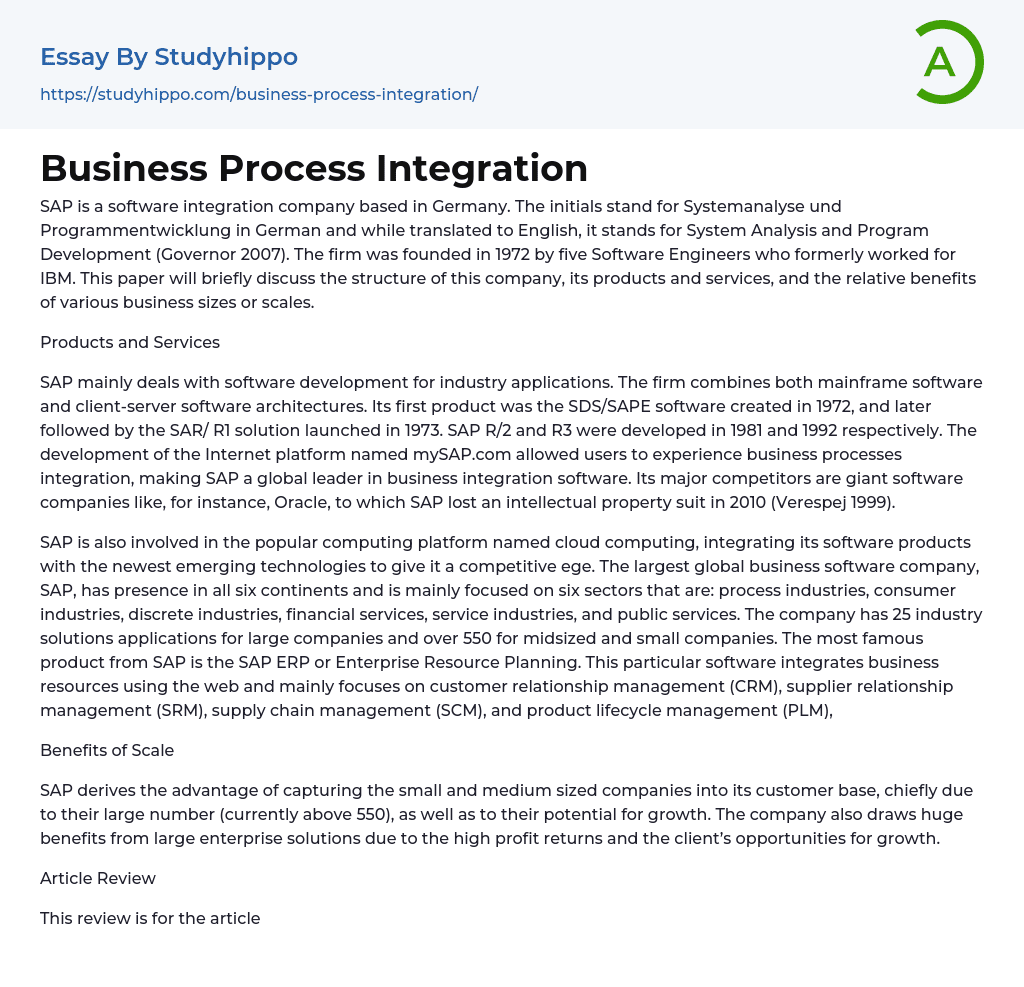SAP is a software integration company based in Germany. The initials stand for Systemanalyse und Programmentwicklung in German and while translated to English, it stands for System Analysis and Program Development (Governor 2007). The firm was founded in 1972 by five Software Engineers who formerly worked for IBM. This paper will briefly discuss the structure of this company, its products and services, and the relative benefits of various business sizes or scales.
Products and Services
SAP mainly deals with software development for industry applications. The firm combines both mainframe software and client-server software architectures. Its first product was the SDS/SAPE software created in 1972, and later followed by the SAR/ R1 solution launched in 1973. SAP R/2 and R3 were developed in 1981 and 1992 respectively. The development of the Internet platform named mySAP.com allowed users to experience business p
...rocesses integration, making SAP a global leader in business integration software. Its major competitors are giant software companies like, for instance, Oracle, to which SAP lost an intellectual property suit in 2010 (Verespej 1999).
SAP is also involved in the popular computing platform named cloud computing, integrating its software products with the newest emerging technologies to give it a competitive ege. The largest global business software company, SAP, has presence in all six continents and is mainly focused on six sectors that are: process industries, consumer industries, discrete industries, financial services, service industries, and public services. The company has 25 industry solutions applications for large companies and over 550 for midsized and small companies. The most famous product from SAP is the SAP ERP or Enterprise Resource Planning. This particular software integrates business resources using th
web and mainly focuses on customer relationship management (CRM), supplier relationship management (SRM), supply chain management (SCM), and product lifecycle management (PLM),
Benefits of Scale
SAP derives the advantage of capturing the small and medium sized companies into its customer base, chiefly due to their large number (currently above 550), as well as to their potential for growth. The company also draws huge benefits from large enterprise solutions due to the high profit returns and the client’s opportunities for growth.
Article Review
This review is for the article titled Enterprise Resource Planning (ERP). The article is about the application of business software to consolidate resources into a web-based platform and enhance efficiency, customer experience, and eaase of access. It looks into the IT effects on a business, including the informational, sequential, geographical, automation, and transactional effects. It also redefines business engineering as the process of enhancing speed, efficiency, and quality of the output through the use of I.T. This transformation is mainly geared towards adapting to the current rapidly changing world. Most ERP processes are built around client-server platform. It also deals with the evolution of ERP as a product of need through the 90s. Further, it briefly discusses ERP verticals, the general model of ERP, as well as its management.
As regards ERP structure, the article discusses both the computer network and the inter-network structures such as user groups. It guides the reader on how to select a suitable ERP based on business needs such as sale volumes and nature of transactions among other factors. This also guides on the time when an enterprise needs an ERP solution as well as the necessary adjustments, such
as staff training, resource allocation, and centralization. The article lastly looks into different ERP packages as offered by different companies such as SAP. It compares the venders in terms of general products description, market experience, and products diversity. In conclusion, the article re-evaluates the importance of enterprises in business processes integration with the core tool being information technology (Governor 2007).
- Accounting essays
- Marketing essays
- Automation essays
- Business Cycle essays
- Business Model essays
- Business Operations essays
- Business Software essays
- Corporate Social Responsibility essays
- Infrastructure essays
- Logistics essays
- Manufacturing essays
- Multinational Corporation essays
- Richard Branson essays
- Small Business essays
- Cooperative essays
- Family Business essays
- Human Resource Management essays
- Sales essays
- Market essays
- Online Shopping essays
- Selling essays
- Strategy essays
- Management essays
- Franchising essays
- Quality Assurance essays
- Business Intelligence essays
- Corporation essays
- Stock essays
- Shopping Mall essays
- Harvard Business School essays
- Harvard university essays
- Trade Union essays
- Cooperation essays
- News Media essays
- Waste essays
- Andrew Carnegie essays
- Inventory essays
- Customer Relationship Management essays
- Structure essays
- Starting a Business essays
- Accounts Receivable essays
- Auditor's Report essays
- Balance Sheet essays
- Costs essays
- Financial Audit essays
- International Financial Reporting Standards essays
- Tax essays
- Accountability essays
- Cash essays
- Principal essays




